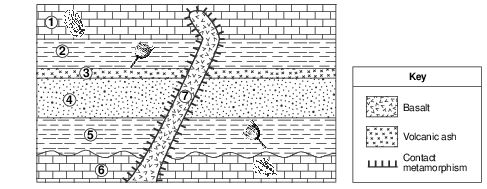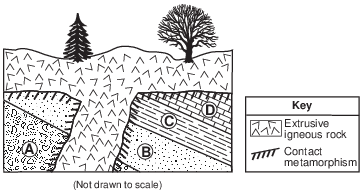Topic: Sedimentary Rock Identification
Sedimentary Rock Identification
Which rock is classified as an evaporite?
(1) clastic shale
(2) foliated phyllite
(3) nonfoliated marble
(4) crystalline rock salt
Which chart correctly matches rock salt and rock gypsum with how the minerals from these rocks are used?
(1) 
(2) 
(3) 
(4) 

Which rock is most likely to form directly from rock material at a depth of 30 km and a temperature of 1000°C?
(1) quartzite
(2) scoria
(3) shale
(4) granite
Which medium-grain-sized metamorphic rock is composed mostly of the same mineral as the sedimentary rock limestone?
(1) gneiss
(2) marble
(3) quartzite
(4) schist
Which rock is composed of the mineral halite that formed when seawater evaporated?
(1) limestone
(2) dolostone
(3) rock gypsum
(4) rock salt

Which lettered box could represent the rock conglomerate?
(1) E
(2) G
(3) C
(4) D

Which limestone is classified as inorganic?
(1) chalk
(2) coquina
(3) coral
(4) travertine
A mixture of rounded pebbles and sand was deposited in a river. Over time, these sediments were compacted and cemented together to form the sedimentary rock
(1) conglomerate
(2) sandstone
(3) breccia
(4) shale

This rock should be classified as
(1) an intrusive igneous rock
(2) an extrusive igneous rock
(3) a bioclastic sedimentary rock
(4) a clastic sedimentary rock
Carrara Marble
Carrara marble is named for the town of Carrara on the west coast of Italy. This dazzling white marble has been mined since the time of the ancient Romans and remains the major industry of the area today. The marble has many commercial uses, such as tombstones, countertops, tiles, and building stones. Its chemical purity, uniform color, and hardness make this marble an ideal material for artists who carve statues from rock. Major museums around the world have statues carved from Carrara marble.
The formation of Carrara marble began 200 million years ago when a great thickness of tiny shells was deposited at the bottom of a warm, shallow sea. Over time, burial and compaction of these sediments formed sedimentary rock primarily composed of pure calcite. Approximately 27 million years ago, tectonic forces caused this area of the seafloor bedrock to be deformed and metamorphosed, forming the Carrara marble. Uplift and erosion later exposed huge formations of this famous marble.
Identify the most likely sedimentary rock that formed when the sediments of tiny shells were buried and compacted. [1]
Allow 1 credit for limestone or coquina.

Identify, by name, the sedimentary rock layer that is missing from rock outcrop III due to the formation of unconformity X. [1]
Allow 1 credit for limestone.

State the grain size of the sediment that was deposited to form rock unit 2. [1]
Allow 1 credit for clay or for a size equal to or less than 0.0004 cm.

Describe one piece of evidence that suggests that rock layer C formed in a deeper sea environment than did rock layer A. [1]
Allow 1 credit. Acceptable responses include, but are not limited to:
• — The grain size of rock layer C is smaller.
• — Smaller sediment is deposited in deeper water.
• — Shale is made of clay-sized particles/clay.
• — Rock layer A contains larger sediments.
Dinosaur Fossils Bones of juvenile long-necked sauropod dinosaurs, Abydosaurus mcintoshi, have recently been found in 105-million-year-old sandstone at the Dinosaur National Monument in Utah. The remains of four individual dinosaurs were found, including two intact skulls. This find is unusual because the softer tissue holding the thin sauropod dinosaur skull bones together usually disintegrates, allowing the skull bones to separate. Only 8 of 120 types of sauropods discovered have complete skull specimens. These dinosaurs were herbivores, with large numbers of sharp teeth that were probably replaced five to six times each year. These teeth allowed only for the harvesting of plant material, but not for chewing it afterward. The plant-harvesting teeth and long neck identify Abydosaurus mcintoshi as a descendant of the brachiosaurs.
Indicate the range of grain sizes in the type of bedrock in which Abydosaurus mcintoshi bones were found. [1]
_____________ cm to _____________ cm
Allow 1 credit. Acceptable responses include, but are not limited to:
• — 0.006 cm to 0.2 cm
• — 0.2 cm to 0.006 cm

The beach consists of particles with diameters from 0.01 cm to 0.1 cm. Identify the sedimentary rock that will form when burial and cementation of these sediments occur. [1]
Allow 1 credit for sandstone.
